
Business Continuity Planning in 4 Steps
There are many reasons why your company needs a business continuity plan. Having a strategy – before an event happens – helps to maximize the chance your business can recover while minimizing the loss of property, life and assets.
Developing your business continuity plan should be a thoughtful process resulting in a plan that can be beneficial to you if an event occurs.
Start by assembling a team of key decision-makers who will lead your continuity planning efforts. Senior management, team leaders and anyone with in-depth knowledge about business operations should be included.

Four Steps to Developing an Effective Business Continuity Plan
- Identify threats or risks
Understanding the risks that could leave employees, customers, vendors, property and operations vulnerable is fundamental. Threats can include, but are not limited to natural disasters, malicious attacks, power outages and system failures.Identify the risks most likely to occur based on historical, geographical, organizational and other factors. Then weigh the probability of each event against its potential impact to your business, as well as your readiness to respond.
- Conduct a business impact analysis
Identify the people, places, providers, processes and programs critical to the survival of your business. What functions and resources, if interrupted or lost, could impact your ability to provide goods and services or meet regulatory requirements?
Consider who and what is absolutely necessary to restore critical operations. Then prioritize the need to restore each item after the event. Plan to use limited resources wisely. Complementary functions can always be restored later.
- Adopt controls for prevention and mitigation
Prevention and mitigation planning and activities are intended to help prevent an event (such as a fire or explosion from unsafe conditions) as well as to reduce the impact or severity of an event (such as relocating critical equipment to a higher elevation in flood-susceptible areas).
Your prevention and mitigation plans should address, among other things, emergency response, public relations, resource management, and employee communications.
- Test, exercise and improve your plan routinely
A business continuity plan is an evolving strategy that should adapt to your company’s ever-changing needs. Test and update it regularly – yearly at a minimum – or any time critical functions, facilities, suppliers or personnel change. Train employees to understand their role in executing the plan, too.
Exercises can include discussions or hypothetical walk-throughs of scenarios to live drills or simulations. The key is to ensure the plan works as intended.
Source: Travelers Insurance
For a quote on your business insurance contact us today!
Categories: Blog
